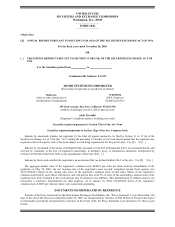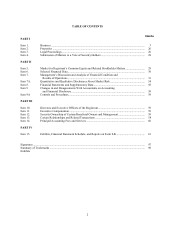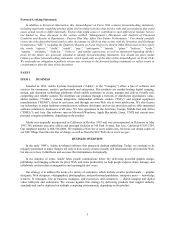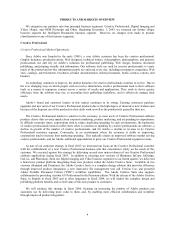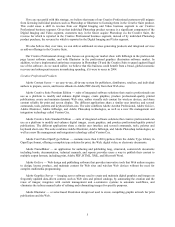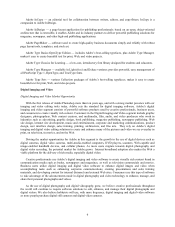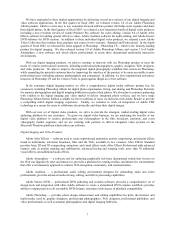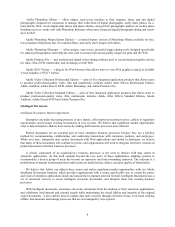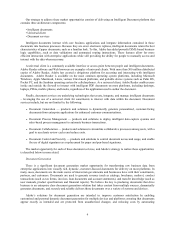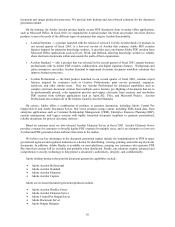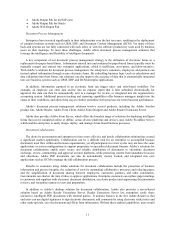Adobe 2003 Annual Report Download - page 4
Download and view the complete annual report
Please find page 4 of the 2003 Adobe annual report below. You can navigate through the pages in the report by either clicking on the pages listed below, or by using the keyword search tool below to find specific information within the annual report.4
PRODUCTS AND MARKETS OVERVIEW
We categorize our products into four principal business segments: Creative Professional, Digital Imaging and
Video, ePaper, and OEM Postscript and Other. Beginning December 1, 2003, we renamed our former ePaper
business segment the Intelligent Documents business segment. However, no changes were made to product
classifications in any of the business segments.
Creative Professional
Creative Professional Market Opportunity
Since Adobe was founded in the early 1980’s, a core Adobe customer has been the creative professional.
Graphic designers, production artists, Web designers, technical writers, videographers, photographers, and prepress
professionals use and rely on Adobe’s solutions for professional publishing, Web design, business document
publishing, and printing visually rich information. Our software tools are used by creative professionals to create
much of the printed and on-line information people see and read every day, including newspapers, magazines, Web
sites, catalogs, advertisements, brochures, product documentation, technical manuals, books, memos, reports, and
banners.
As technology continues to improve, the market dynamics for creative professionals continue to evolve. Due to
the ever changing ways in which people wish to receive information, creative professionals look to their software
tools as a means to repurpose content across a variety of media and applications. They wish to derive greater
efficiency from the software they use, to streamline their publishing workflows, and to effectively manage their
assets.
Adobe’s brand and customer loyalty in this market continues to be strong. Existing customers purchase
upgrades and new units of our Creative Professional products due to the high degree of innovative new features and
because of the frequent use of the products in their daily work as well as the productivity gained by their use.
The Creative Professional market is sensitive to the economy, as most users of Creative Professional software
products derive their revenue mainly from corporate marketing, product marketing, and ad spending in corporations.
In difficult economic times, corporations tend to reduce marketing spending. In such environments, the businesses
of creative professionals tends to suffer; there often is a decline in spending by creative professionals on software, a
decline in growth of the number of creative professionals, and for Adobe, a decline in revenue in its Creative
Professional customer segment. Conversely, in an environment where the economy is stable or improving,
corporations tend to increase their marketing spending. This typically creates an improved software market serving
creative professionals, and for Adobe, additional opportunities to grow our Creative Professional segment revenue.
As part of our corporate strategy in fiscal 2003, we increased our focus on the Creative Professional customer
with the establishment of a new Creative Professional business unit that concentrates solely on the needs of this
customer. We executed against this strategy by delivering several new major releases of our Creative Professional
software applications during fiscal 2003. In addition to releasing new versions of Illustrator, InCopy, InDesign,
GoLive, and Photoshop (from our Digital Imaging and Video business segment) in our fourth quarter, we delivered
a brand new product platform integrating these new products called the Adobe Creative Suite. Available in two
versions (Standard and Premium), the Adobe Creative Suite is a complete design solution that provides efficiency
through improved product integration, a new innovative file management tool call Version Cue, and powerful
Adobe Portable Document Format (“PDF”) workflow capabilities. The Adobe Creative Suite also supports
collaboration by providing Acrobat 6.0 Professional in the Premium edition. With the release of the Adobe Creative
Suite, in English in fiscal 2003 and in other languages in fiscal 2004, we will market the complete design and
publishing platform benefits and overall value of this new product to customers.
We will continue this strategy in fiscal 2004, focusing on increasing the number of Adobe products our
customers use by delivering more value to them, and, by enabling more efficient collaboration and workflow
through improved product integration.

